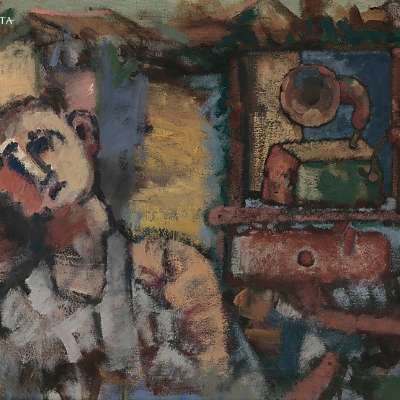Lotsman Alexander
Alexander Lotsman was born in Khakassia in 1947. When he was six, the family moved to Achinsk, a small town in central Siberia not far from Krasnoyarsk where he spent his childhood. He still remembers the people from that town: strange characters who looked as if they had stepped out of Filonov’s paintings – outwardly sullen but open and sincere inwardly, quite different from the inhabitants of big cities.
It was in Achinsk where Lotsman started to take an interest in art. The young man attended classes at a local art studio and later on went to the Krasnoyarsk Art College. After graduating, Lotsman served in the army for three years. Upon returning in 1971, he moved to Leningrad with a friend. Lotsman took part in an off-campus study program at the Repin Institute, attended lectures on history at the Leningrad University and spent long hours at the Hermitage and the Russian Museum. At that time his imagination was captured by the artwork of Petrov-Vodkin, Nesterov, and artists of the first half of the twentieth century: Lentulov, Tatlin, Kuprin, and Filonov. The artist confessed that he would go to the Russian Museum only to have a look at The Great Taking of the Veil by Nesterov: after making the long way through museum halls he would stop by this favourite painting and could stand there looking at it for ages.
As the years went by Alexander joined the cultural life of the city quite naturally and felt involved in what was happening around him. He no longer experienced the naïve delight from the embankments and prospects which he had depicted in his first landscapes. The artist was ready to rethink his aesthetics and attitude to the subject. These changes brought about a new serious phase of his artistic career. When the unofficial Society for Experimental Visual Art (TEII) began to exhibit in the 1980s, the artist took part in its exhibitions in the USSR and, after the collapse of the Soviet Union, abroad.
In the 1990s, Alexander Lotsman made connections with Pushkinskaya-10, the first art centre that emerged in the city quite spontaneously and after a while was recognizsd by the authorities. Pushkinskaya was, and still is, home to many artists. A solid artistic fellowship under this one roof helped the artist set up his own studio.
However, Lotsman found that city life couldn’t hold his attention indefinitely. In search of adventure, he travelled around the country every year, moving away from the noisy crowded streets to where he could peacefully work on his favourite genre, the landscape. ‘The most important things in a picture for me are colours, composition, harmony of tones and spots that produce this artistic musical chord, intuitive sounds and spirits coming from canvas’, Alexander used to say about his works.
The artist passed away in 2022.






